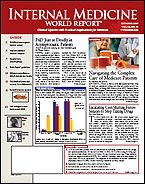Publication
Article
Internal Medicine World Report
Bariatric Surgery the Preferred Treatment for Obese Diabetics
Author(s):
Disease Remission >4 Times Greater versus Conventional Therapy
Disease Remission >4 Times Greater versus Conventional Therapy
By Jill Stein
CHICAGO—Surgically induced weight loss provides significant benefits for the management of type 2 diabetes in obese patients compared with conventional therapy, researchers announced at the American Diabetes Association annual meeting.
The surgical procedure used in the study involved the placement of a laparoscopic adjustable gastric band (LAGB), known as bariatric surgery. This is the first randomized trial to compare bariatric surgery and conventional therapy in this patient population.
The data, reported by an Australian team, demonstrated weight loss, glycemic control, and diabetes remission rates with surgery that were superior to conventional therapies at 2-year follow-up.
"Based on our results, we believe that LAGB placement should be considered when planning a treatment program for obese subjects diagnosed with type 2 diabetes," said John B. Dixon, MBBS, senior research fellow and director of the Center for Obesity Research and Education at Monash University in Melbourne, Australia.
A total of 60 patients with a body mass index (BMI) >30 kg/m2 and < 40 kg/m2 with type 2 diabetes, diagnosed within the last 2 years, were randomized to a program of conventional diabetes therapy alone or conventional therapy plus LAGB placement to induce substantial weight loss.
The conventional program used the best available medical practice for treatment, education, and follow-up, with open access to a general physician, dietitian, and/or diabetes educator, and visits every 6 weeks throughout the 2-year study. All prescribed medications were selected by an experienced diabetologist. Lifestyle modifications were recommended to reduce the intake of energy and saturated fats and encourage a low-glycemic-index/high-fiber diet, physical activity (10,000 steps a day or 200 min/wk of moderate-intensity aerobic activity and resistance exercise), and a low-calorie diet. Medication was given, if appropriate.
Patients assigned to surgery participated in all aspects of the conventional therapy program. LABG placement (pars flaccida technique) was performed within 1 month of randomization.
The primary end point was the percent of patients achieving remission (exceptional glycemic control) of type 2 diabetes, defined as a fasting plasma glucose < 7.0 mmol/L in addition to hemoglobin (Hb) A1c < 6.2%, without oral hypoglycemic agents or insulin.
Overall, 29 of 30 patients in the surgical group and 26 of 30 in the conventional therapy group completed the trial.
At 2 years, surgical patients achieved a mean 20.7% weight loss compared with 1.7% for conventionally treated patients. "This represents a loss of 65% of excess weight in the surgical group compared with 6% in the conventional therapy group and a BMI reduction from 36.3 kg/m2 to 28.4 kg/m2 versus a reduction from 37.2 kg/m2 to 36.3 kg/m2 for the 2 groups, respectively," Dr Dixon noted.
The remission rate was 76% in the surgery group and 15% in the conventional therapy group.
The percent reduction in HbA1c was 4 times greater in the surgical group than in the conventional group.
Significant reductions in the use of oral hypoglycemic, antihypertensive, and lipid-lowering medications were also observed in the surgical group. No serious complications were reported in either group.
These results show that substantial weight loss induced by LAGB is associated with a significantly better outcome than standard therapy in obese patients with type 2 diabetes, Dr Dixon observed.
He added that the degree of weight loss appeared to be the major driver of glycemic improvement and diabetes remission in obese patients. "This finding has important implications, as it suggests that intensive weight-loss therapy may be an appropriate first-line in diabetes management," he said.
KEY POINTS
- Recommend bariatric surgery in addition to conventional glycemic control therapy for diabetic patients who are obese.
- Superior weight loss, glycemic control, and diabetes remission were seen with surgery compared with conventional therapy at 2 years after surgery.
- Diabetes remission rate was >4 times greater with surgery: 76% in surgically treated patients compared with 15% in those assigned to conventional therapy.





